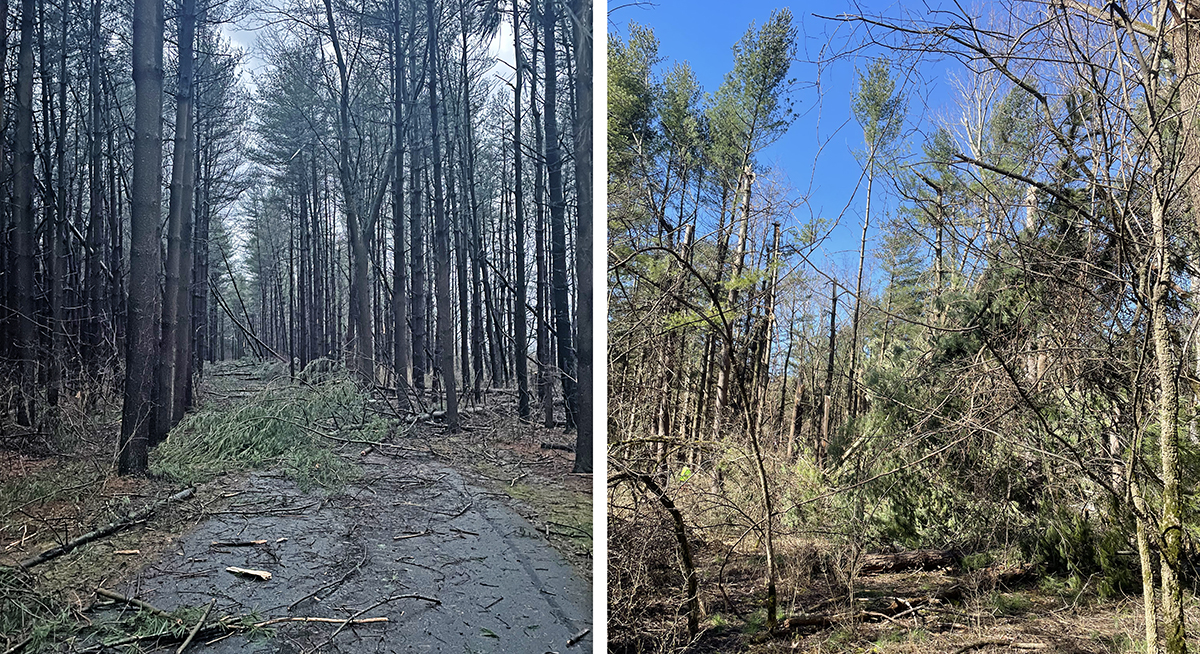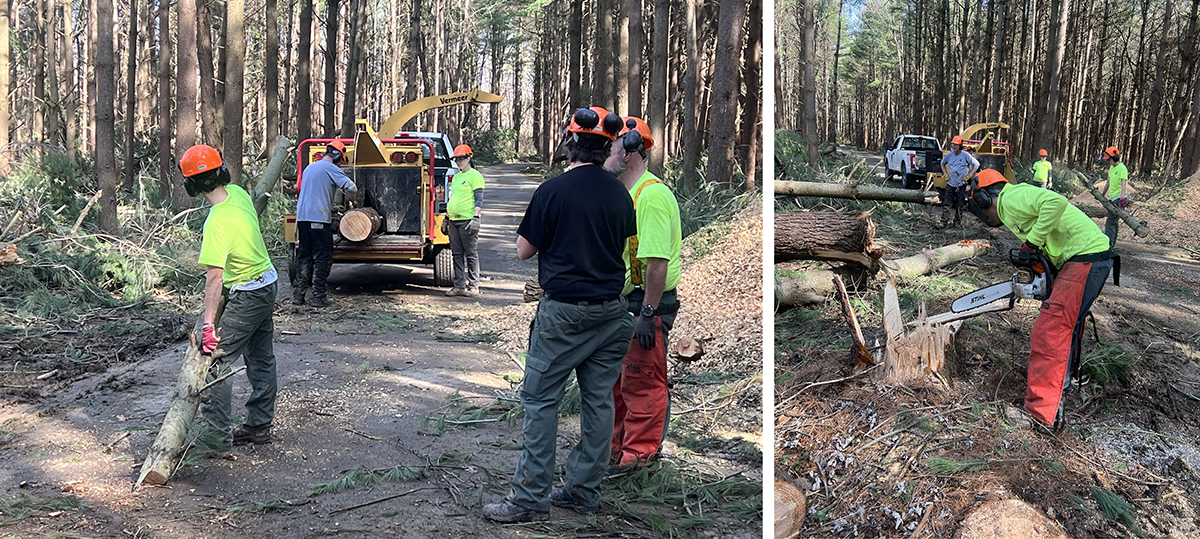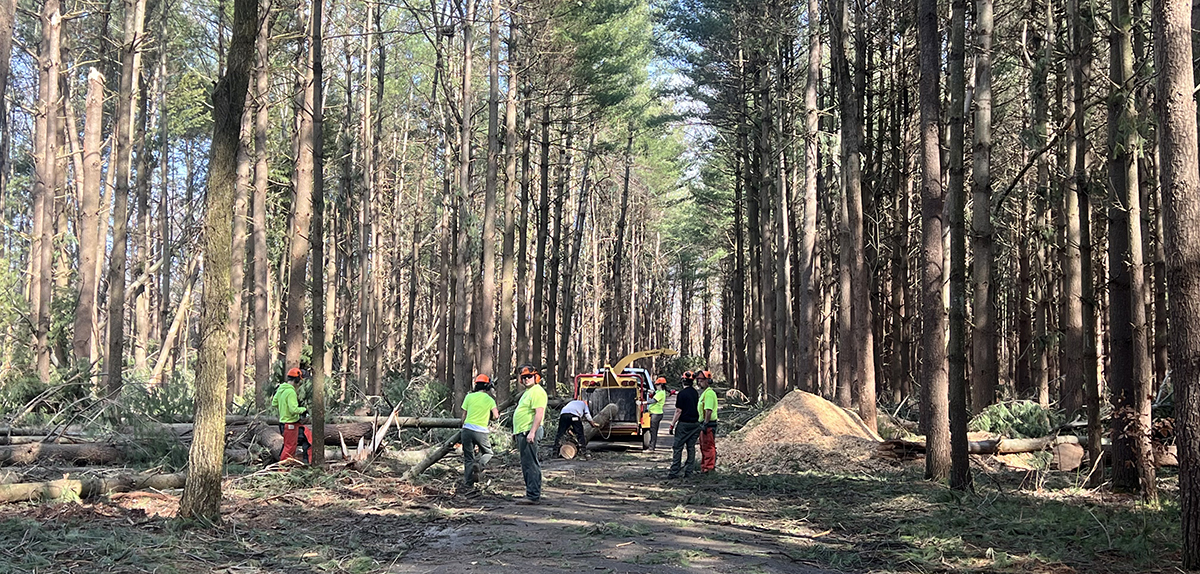OLIVIA PIPER
Resource Management Technician
With recent stormy weather throughout Ohio, you may have noticed dramatic damage to some of the Metro Parks. One park in particular, Walnut Woods, experienced some unsightly destruction due to a nasty storm.
On February 28, 2024, a recorded EF0 tornado made its way to Groveport where it touched down in the Tall Pines Area at Walnut Woods. According to the National Weather Service, the tornado originated on the western edge of the Tall Pines Area and continued eastward towards Canal Winchester. Judging by the extensive tree damage, tall pines was most likely the strongest location/period of the tornado. An EF0 tornado is the lowest and weakest classification of tornados, with winds from 65-85 miles an hour.
Tornado damage can be seen right from the far western edge of the Sweetgum Trail. Additionally, there were even more trees down in an off-trail area between the Sweetgum Trail and the Pin Oak Trail. Several large white pine trees were uprooted and split in half. Limbs and branches were strewn about. The Sweetgum Trail was unrecognizable and buried under mounds of debris.

The extensive damage required the trail to be closed for several days as crews worked diligently to clean up the wreckage. Park maintenance staff, Resource Management staff and staff from other nearby parks worked on cleaning up the mess. Cleanup efforts involved cutting large trunks and limbs into manageable sections, then chipping those sections in a brush chipper. Wood chips were dispersed into large piles along the edge of the trail, then later relocated once ground conditions were suitable for tractor and utility vehicle work.
Unfortunately, the area was already predisposed to destruction given its history. Before Metro Parks acquired the land, it was owned by the City of Columbus. In 1981, the roughly 20 acre area was planted with young trees in rows with the intention of uprooting them to disperse throughout the city’s parks and other natural areas. The trees eventually grew too large to relocate and thus became a man-made forest with monocultures of trees throughout. You may notice many of the pines on the western edge of the area lack lower limbs. This is mostly because the close proximity to one another discourages the growth of these lower limbs. As a result, limbs and branches fall off, creating wounds that are prone to pests and disease that can spread rapidly from tree to tree.

If you visit the trail now, you will find exposed ground which is now penetrable by sunlight. Efforts to remove and control the invasive honeysuckle have been attempted in the past, but now, the fear is that the once manageable honeysuckle will explode with growth given the new excess of sunlight. The honeysuckle and other invasives will thrive in these open, sunny conditions.
The Metro Parks goal is to continue to remove the invasive species, allowing the native woody species to become established. We have already noticed some small native trees and shrubs in the understory that have been struggling to take off underneath the pines’ shade. Some of these species observed include Ohio buckeye (Aesculus glabra), green ash (Fraxinus pennsylvanica) and blackhaw viburnum (Viburnum prunifolium). The goal is to begin assisting the habitat in creating a healthier successional forest. Obtaining this goal will include the continued removal of honeysuckle and other invasive plants, and by doing supplemental plantings of white pines along with other native tree species… but this time, not in rows and with ample distance between plantings.
It’s not all bad news though! While the beloved Tall Pines Area may look a little different now, there are a lot of positive outlooks on the destruction situation. The newly opened area provides the perfect opportunity to create a healthier pine stand. The open area also makes it easier to access invasive species for eradication. The park is also able to use the large quantity of wood chips for trail maintenance and other projects around the park. And while most of the fallen trees around the trail were cleaned up, there are still a lot of logs and limbs down further off the trail which provide great cover habitat for birds, mammals and other small critters to enjoy.

